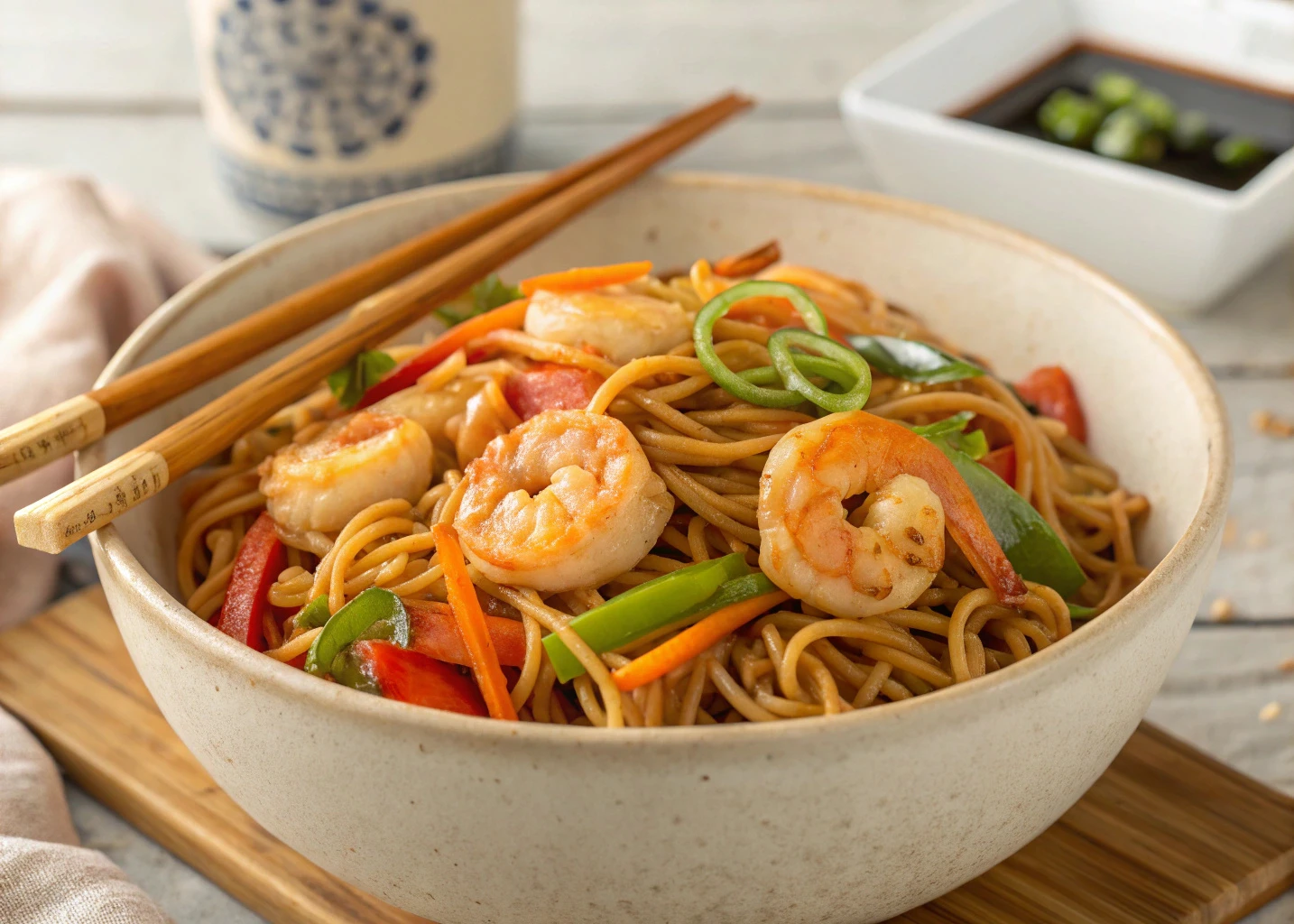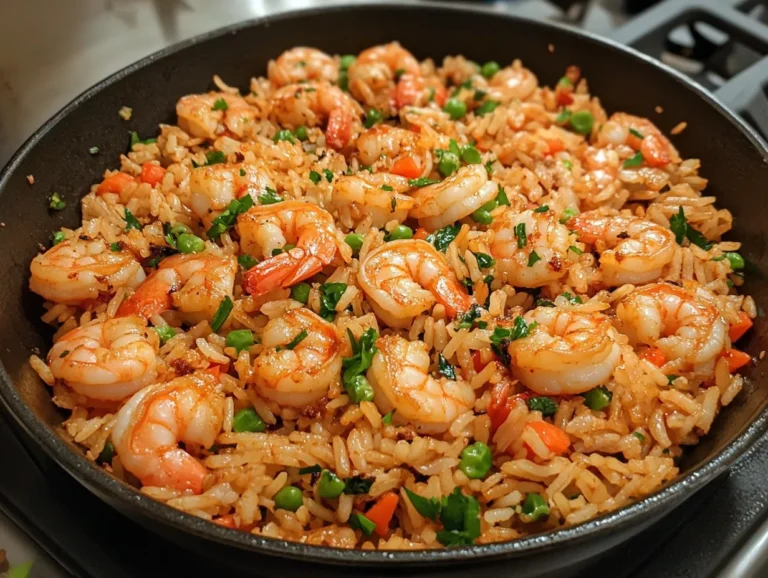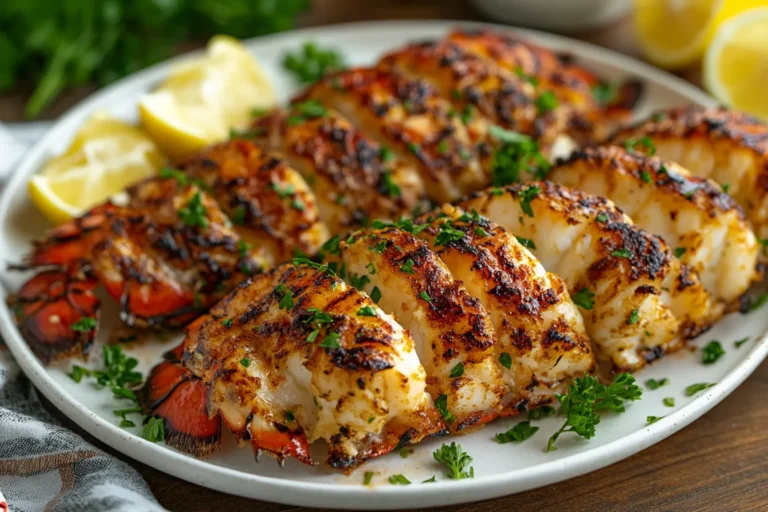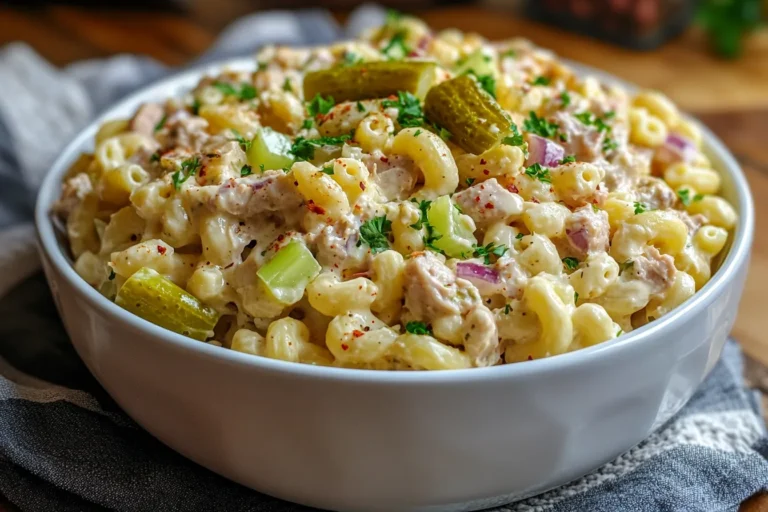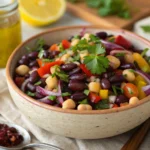Why Shrimp Lo Mein Is the Weeknight Hero
Shrimp Lo Mein is more than just a takeout staple — it’s a fast, flavorful, and deeply satisfying dish that brings together tender shrimp, chewy noodles, fresh vegetables, and a glossy, savory sauce. The beauty of this recipe lies in its simplicity and flexibility.
When made at home, you control every element: seasoning, freshness, texture, and quality. It’s quick enough for a busy night, customizable to your pantry, and delivers that bold, crave-worthy flavor without excess oil, MSG, or mystery ingredients.
Why you’ll want this in your dinner rotation:
- Faster than delivery
- Uses pantry staples and freezer-friendly ingredients
- Balanced with protein, vegetables, and carbs
- Packs serious flavor with minimal effort
Looking for inspiration? Try our Shrimp Fried Rice Recipe for another quick, crave-worthy shrimp dish.
What Makes This Shrimp Lo Mein Better Than Takeout
This isn’t just another stir-fry. This recipe was developed to outperform your favorite takeout version in flavor, texture, and quality — while being healthier and easier to prepare.
Key Advantages
| Feature | Benefit |
|---|---|
| Ready in under 30 mins | Fast enough for a weeknight meal |
| One pan | Minimal cleanup |
| Balanced meal | Includes protein, veggies, and noodles |
| Customizable | Easy to adjust spice level, protein, or noodle type |
| Takeout-style sauce | Classic sweet-savory profile, made without additives |
Highlights:
- Shrimp stays juicy and flavorful
- Noodles are firm, never soggy
- Sauce clings perfectly to every bite
- Veggies stay crisp-tender
- Everything comes together in one wok or skillet
If you’re looking for a dependable, flavorful meal that’s family-approved and dinner-guest worthy, this Shrimp Lo Mein delivers every time.
Ingredient Breakdown – Core Components and Flexible Swaps
Let’s break down the essentials for making restaurant-quality shrimp lo mein at home. Use this section to plan your shopping, prep your pantry, and know your substitutions.
Main Ingredients Overview
| Ingredient | Notes and Substitutions |
|---|---|
| Shrimp (large/medium) | Peeled, deveined. Can be fresh or thawed from frozen. |
| Lo mein noodles | Chinese egg noodles preferred. Spaghetti or ramen work in a pinch. |
| Carrots | Julienned or thinly sliced. Can sub with daikon or parsnip. |
| Bell peppers | Red, green, or yellow. Snap peas or zucchini also work. |
| Cabbage or bok choy | Adds crunch. Napa, green cabbage, or spinach are fine. |
| Green onions | For garnish and flavor. |
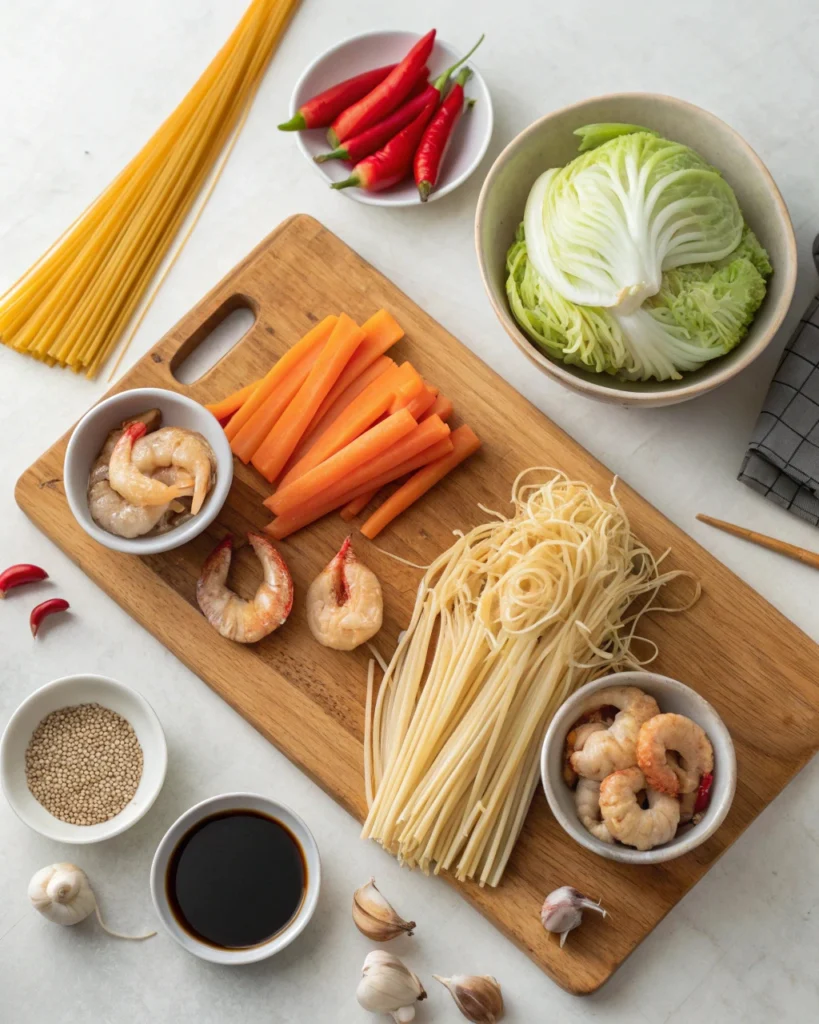
Sauce Ingredients
This sauce gives the lo mein its bold, rich flavor. Mix all ingredients before cooking to streamline the stir-fry process.
- Soy sauce (preferably low-sodium)
- Oyster sauce (adds body and umami)
- Sesame oil (aromatic finish)
- Sugar (balances saltiness)
- Cornstarch (light thickening)
- Water or broth (for consistency)
Optional Add-ins for Personal Flavor:
- Rice vinegar or mirin (for acidity)
- Hoisin sauce (for sweetness and depth)
- Chili garlic sauce or crushed red pepper (for heat)
Expert Tips for Ingredient Prep
- If using frozen shrimp, thaw in cold water and pat completely dry before cooking.
- Use a mix of colorful vegetables for visual appeal and variety in texture.
- Undercook the noodles slightly, as they will finish cooking in the stir-fry.
- Pre-cut stir-fry vegetable mixes can save time while still adding variety.
Prepping the Shrimp – Clean, Marinate, Sear
Shrimp is the star of this dish, and how you prepare it directly impacts the final flavor and texture. Proper prep ensures your shrimp are tender, not rubbery, and sear well in the pan.
Step-by-Step Shrimp Prep
- Thaw properly (if using frozen)
- Place in cold water for 10–15 minutes.
- Drain and pat dry thoroughly with paper towels.
- Peel and devein
- Remove shells and tails.
- Carefully cut along the back of the shrimp to expose and remove the vein.
- Optional marinade (improves flavor and tenderness):
- 1 tsp soy sauce
- ½ tsp sesame oil
- 1 tsp cornstarch
- Dash of white pepper
Let the shrimp marinate for 10–15 minutes while you prepare the remaining ingredients.
Common Mistakes to Avoid
| Mistake | Why It Hurts the Dish |
|---|---|
| Overcooking shrimp | Leads to a tough, rubbery texture |
| Skipping the dry-off step | Causes shrimp to steam instead of sear |
| Not deveining | Can leave gritty, unpleasant texture |
For the best results, cook shrimp over high heat in a single layer — and remove them from the pan once just opaque to prevent overcooking during stir-frying.
Looking for more shrimp-based dinner ideas? Our Cajun Shrimp Pasta Recipe offers a completely different flavor profile with the same weeknight-friendly ease.
Choosing and Cooking the Right Noodles
Noodles define the texture and body of lo mein. Choosing the right type and cooking them properly ensures they stay firm and don’t turn into a sticky, overcooked mess.
Best Noodle Options
| Noodle Type | Notes |
|---|---|
| Lo mein (fresh) | Authentic texture, cooks in minutes, often refrigerated |
| Lo mein (dried) | Widely available, needs boiling like pasta |
| Ramen (no seasoning) | Acceptable substitute when lo mein isn’t available |
| Spaghetti | Western alternative with similar structure |
| Udon | Thicker and chewier, for a heartier version |
Cooking Instructions
- Boil in salted water until just under al dente
- Drain and rinse with cold water to stop cooking
- Lightly toss the noodles with a small amount of oil to keep them from sticking together.
Tip: Fresh lo mein noodles usually require only a quick soak or 1–2 minutes in boiling water.
Step-by-Step Cooking Instructions
Once your shrimp is prepped, noodles are cooked, and vegetables are chopped, it’s time to cook. This is a high-heat, fast-moving stir-fry, so having everything ready is essential.
Mise en Place Checklist
- Shrimp: cleaned and optionally marinated
- Noodles: cooked and oiled
- Sauce: mixed and ready in a small bowl
- Vegetables: all sliced and ready
- Pan: large wok or wide nonstick skillet, heated
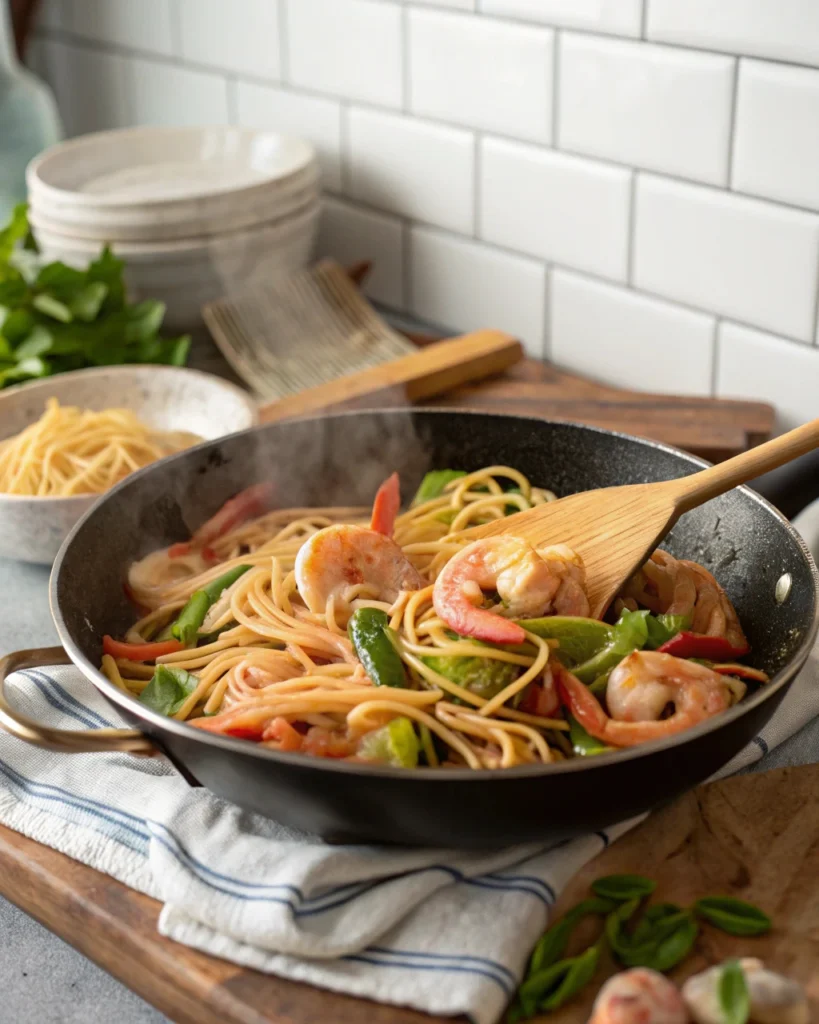
Stir-Frying Process
| Step | Action | Notes |
|---|---|---|
| 1 | Heat 1–2 tbsp oil in a hot wok or skillet | High smoke point oil like avocado, peanut, or canola is best |
| 2 | Add shrimp and sear for 1–2 minutes per side | Remove once just opaque |
| 3 | Stir-fry vegetables until crisp-tender | Start with harder ones like carrots |
| 4 | Add cooked noodles to the pan | Toss quickly to heat through |
| 5 | Return shrimp to pan | Combine with noodles and veggies |
| 6 | Pour in sauce and stir until everything is coated | Sauce will thicken slightly |
| 7 | Taste and adjust seasoning | Add soy, sugar, or chili if needed |
Tips for Success
- Use high heat for fast cooking and a slight sear.
- Stir constantly to avoid burning or uneven cooking.
- Add sauce last to prevent it from evaporating too quickly.
Customization Options – Make It Your Own
Shrimp Lo Mein is incredibly adaptable. Whether you’re feeding picky eaters, sticking to a diet, or using what’s in your fridge, there are plenty of smart swaps and enhancements you can make.
Protein Variations
| Option | How to Use |
|---|---|
| Chicken | Thinly slice and stir-fry until golden before adding veggies |
| Beef | Use flank or sirloin, cut across the grain |
| Tofu | Press, cube, and pan-fry until crispy |
| Eggs | Scramble in the pan before noodles for extra protein |
Tip: Any protein should be cooked separately and re-added with the noodles to maintain texture.
Vegetable Swaps
Use what you have on hand or add more variety:
- Broccoli florets
- Snow peas or sugar snap peas
- Mushrooms (shiitake, cremini, or button)
- Bean sprouts
- Zucchini or yellow squash (thinly sliced)
Diet-Friendly Adjustments
| Diet Type | Substitutions |
|---|---|
| Gluten-Free | Use tamari instead of soy sauce, rice noodles instead of wheat |
| Low-Carb | Try shirataki noodles or zucchini noodles |
| Vegetarian | Skip shrimp, use tofu or extra vegetables |
Flavor Modifiers
- Add chili flakes or chili oil for heat
- Use hoisin sauce for a sweeter profile
- Splash in rice vinegar or lime juice for tang
- Include fresh grated ginger for extra aroma
Storage, Reheating, and Meal Prep Tips
Shrimp Lo Mein makes great leftovers and can even be prepped in stages to make dinner even faster the next day.
Storing Leftovers
- Refrigerator: Store in an airtight container for up to 3 days.
- Freezing: Not recommended due to texture loss in shrimp and noodles.
Reheating Methods
| Method | Instructions |
|---|---|
| Skillet | Reheat with 1–2 tbsp water or broth over medium heat, stirring frequently |
| Microwave | Add a splash of water and loosely cover. Heat in short bursts, stirring between rounds |
Avoid overcooking during reheating to keep shrimp tender and noodles from drying out.
Make-Ahead Tips
- Prepare sauce up to 3 days in advance and store in the fridge.
- Slice vegetables and store in a sealed container.
- Cook and refrigerate noodles separately; toss together just before serving.
How to Serve Shrimp Lo Mein
This dish is complete on its own, but if you’re serving a larger meal or want to create an Asian-inspired menu, pair it with complementary sides and drinks.
Serving Suggestions
| Category | Options |
|---|---|
| Appetizers | Vegetable spring rolls, scallion pancakes, dumplings |
| Light sides | Cucumber salad, steamed edamame, sesame slaw |
| Soups | Miso soup, egg drop soup, hot and sour soup |
| Garnishes | Toasted sesame seeds, chopped scallions, chili oil |
Drink Pairings
- Iced green tea or jasmine tea
- Ginger-infused lemonade
- Sparkling water with lime
Hosting Tip
Serve Shrimp Lo Mein family-style in a large platter with chopsticks, lime wedges, and garnishes on the side for an easy, crowd-pleasing presentation.
If you’re a fan of shrimp-based Asian dishes, you’ll also enjoy learning how to make a crispy Shrimp Tempura Roll — a perfect appetizer or sushi-style side to serve alongside lo mein.
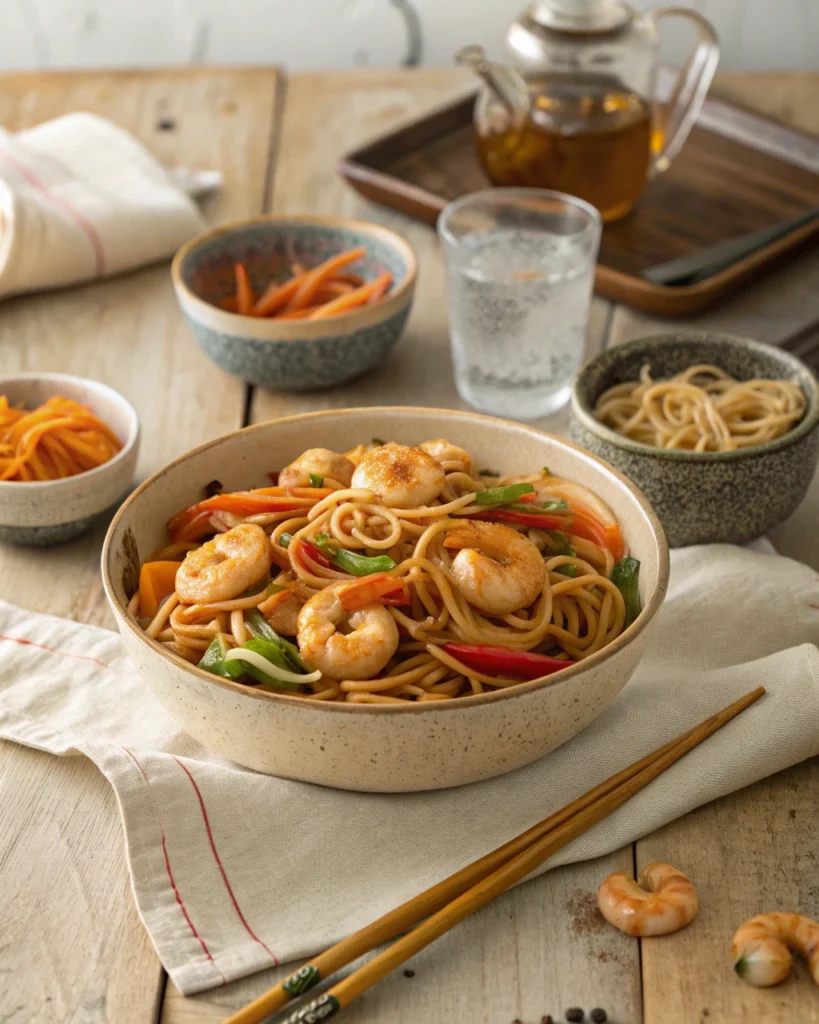
Expert Tips and Mistakes to Avoid
To take your Shrimp Lo Mein from good to exceptional, pay attention to the techniques that separate a rushed stir-fry from a restaurant-style dish.
Cooking Tips That Make a Difference
- Use high heat: Stir-frying is fast cooking. Preheat your wok or skillet thoroughly to develop a light sear on ingredients.
- Prep everything in advance: Stir-frying happens quickly. Chop, mix, and measure before turning on the stove.
- Cook in stages: Sear shrimp first, then vegetables, then combine with noodles and sauce. This prevents overcooking.
- Use cornstarch in your sauce: Helps the sauce cling to the noodles and gives it body without being heavy.
- Finish with sesame oil, not earlier: Sesame oil is a finishing oil — adding it during cooking can cause it to lose aroma.
If you prefer salmon, our Teriyaki Salmon Recipe is another quick Asian-inspired dinner that shares similar seasoning notes.
Common Mistakes to Avoid
| Mistake | Why It Hurts the Dish |
|---|---|
| Overcrowding the pan | Leads to steaming, not stir-frying |
| Overcooking shrimp | Results in a rubbery texture |
| Skipping the noodle rinse | Causes clumping and mushy texture |
| Pouring in sauce too early | Evaporates flavor before it coats ingredients |
| Using raw vegetables together | Different veggies need different cook times |
By following these tips, your lo mein will have the right texture, balanced flavor, and that signature restaurant-style finish every time.
Frequently Asked Questions
These questions are based on common search queries and help improve SEO performance, particularly for featured snippets and voice search.
Can I use frozen shrimp?
Yes. Thaw completely in cold water, then pat dry before cooking to ensure proper searing. Avoid cooking shrimp directly from frozen as it will release too much water.
What are lo mein noodles made of?
Traditional lo mein noodles are made from wheat flour and eggs. They’re slightly chewy and designed to hold up to stir-frying. You can substitute with ramen or spaghetti if needed.
What’s the difference between lo mein and chow mein?
- Lo Mein translates to ‘tossed noodles,’ referring to noodles that are boiled first, then stir-fried with sauce.
- Chow Mein means “fried noodles” — the noodles are often crisped or stir-fried separately.
Can I make this vegetarian?
Yes. Simply omit the shrimp and use tofu, mushrooms, or a combination of hearty vegetables instead. You may also want to replace oyster sauce with hoisin or mushroom stir-fry sauce.
Is this dish spicy?
Not by default. The base recipe is mild. To make it spicy, add chili garlic sauce, sriracha, red pepper flakes, or fresh chilies during cooking or as a garnish.
Can I make it in advance?
Yes. You can:
- Pre-chop vegetables
- Mix the sauce ahead of time
- Cook the noodles and store them lightly oiled in the fridge
For best results, cook the shrimp and assemble everything fresh when serving.
Conclusion: Why This Shrimp Lo Mein Belongs in Your Weekly Rotation
This Shrimp Lo Mein recipe delivers everything you want from a great stir-fry: speed, simplicity, flavor, and flexibility. From juicy, seared shrimp to chewy noodles coated in a rich, balanced sauce, every bite is satisfying and full of texture. Whether you’re looking to skip takeout, feed a family, or prep ahead for the week, this dish adapts effortlessly.
With the right technique, fresh ingredients, and a well-balanced sauce, anyone can master this classic — no fancy tools or culinary training required. Make it once, and it’s likely to become one of your most requested meals.
Craving more Asian-style comfort food? Don’t miss our Beef and Broccoli Recipe — another quick and delicious stir-fry favorite.
Ready to make it tonight? Don’t forget to bookmark this guide so you can revisit it whenever those lo mein cravings hit.
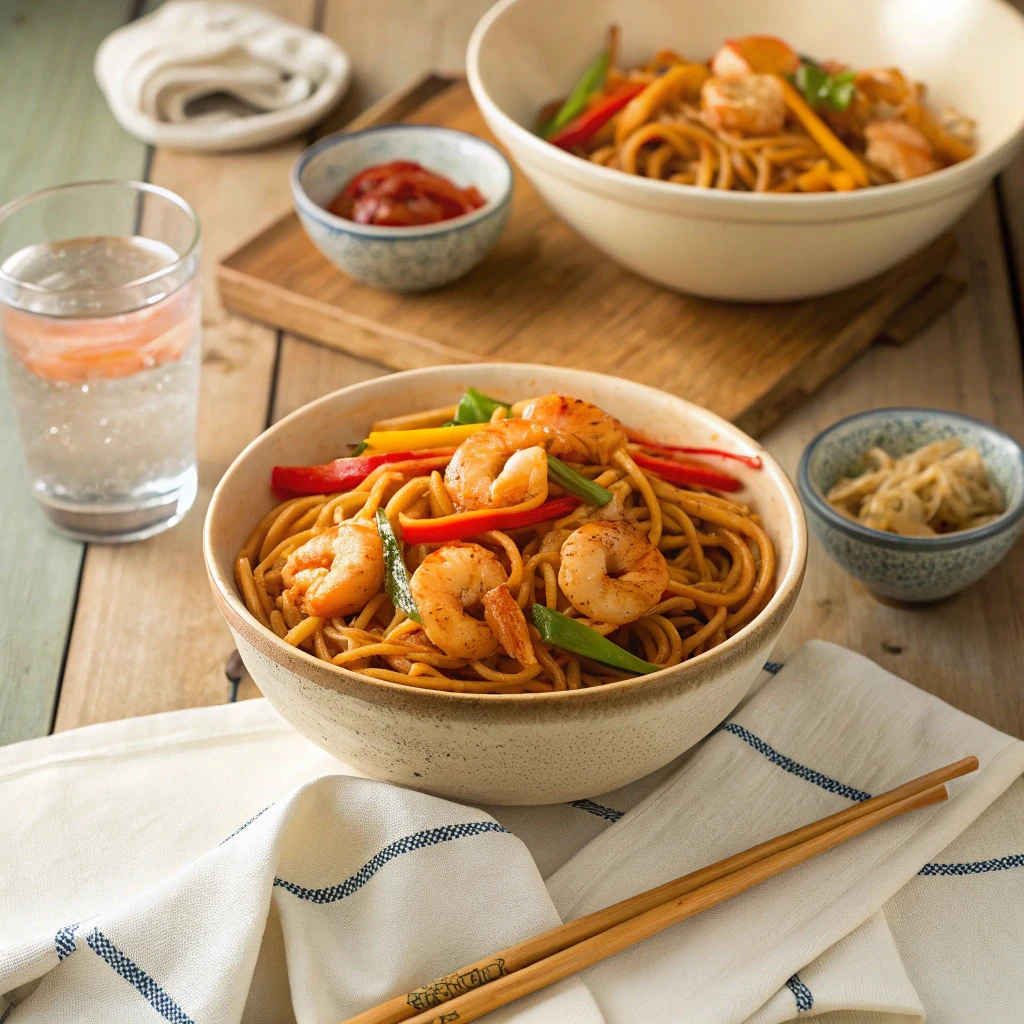
Shrimp Lo Mein
Ingredients
Equipment
Method
- Cook noodles according to package instructions. Rinse under cold water and toss with a little oil to prevent sticking. Set aside.
- Pat shrimp dry. Optional: marinate with soy sauce, sesame oil, and cornstarch for 10–15 minutes.
- Mix soy sauce, oyster sauce, sesame oil, sugar, cornstarch, and water in a small bowl to form the sauce.
- Heat oil in a large wok or skillet over high heat. Add shrimp and cook for 1–2 minutes per side until opaque. Remove and set aside.
- Add garlic and stir-fry vegetables for 2–3 minutes until crisp-tender.
- Add cooked noodles to the pan and toss with vegetables.
- Return shrimp to the pan. Pour in sauce and stir everything together for 1–2 minutes until evenly coated.
- Garnish with green onions. Serve hot.
Notes
- Noodle Tip: If using dried lo mein or spaghetti, cook just until al dente, then rinse with cold water to stop cooking. Toss with a small amount of oil to prevent clumping.
- Shrimp Tip: For the best texture, use large shrimp and cook on high heat until just opaque. Avoid overcrowding the pan to get a proper sear.
- Vegetable Variations: Feel free to add broccoli, mushrooms, snap peas, or bean sprouts. Just make sure to stir-fry harder vegetables (like carrots or broccoli) a bit longer than soft ones.
- Make It Ahead: You can prep the sauce, chop vegetables, and even cook the noodles in advance. Store everything separately in the fridge and combine just before serving.
- Spicy Version: Add chili garlic sauce, red pepper flakes, or a drizzle of homemade chili oil for extra heat.
- Leftovers: Store in an airtight container for up to 3 days. Reheat in a skillet with a splash of broth or water to bring back moisture.


